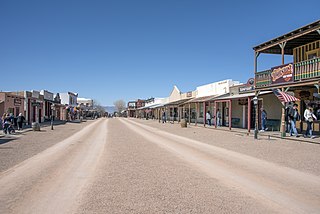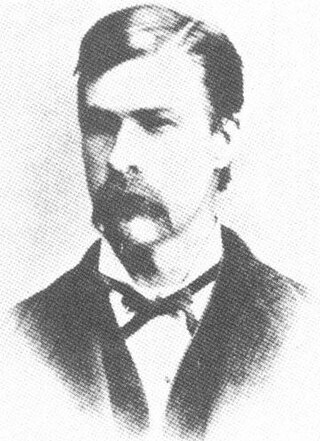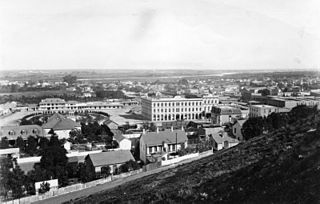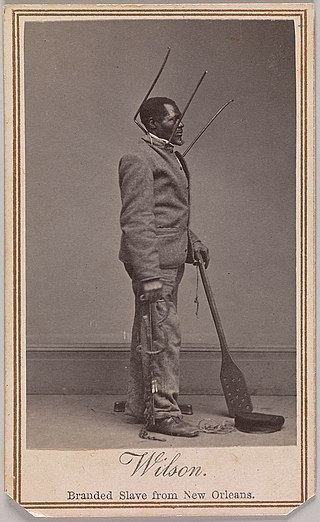
Tombstone is a city in Cochise County, Arizona, United States, founded in 1879 by prospector Ed Schieffelin in what was then Pima County, Arizona Territory. It became one of the last boomtowns in the American frontier. The town grew significantly into the mid-1880s as the local mines produced $40 to $85 million in silver bullion, the largest productive silver district in Arizona. Its population grew from 100 to around 14,000 in less than seven years. It is best known as the site of the Gunfight at the O.K. Corral and presently draws most of its revenue from tourism.

Wyatt Berry Stapp Earp was an American lawman and gambler in the American West, including Dodge City, Deadwood, and Tombstone. Earp was involved in the famous gunfight at the O.K. Corral, during which lawmen killed three outlaw Cochise County Cowboys. While Wyatt is often depicted as the key figure in the shootout, his brother Virgil was both Deputy U.S. Marshal and Tombstone City Marshal that day and had considerably more experience in law enforcement as a sheriff, constable, and marshal than did Wyatt. Virgil made the decision to enforce a city ordinance prohibiting carrying weapons in town and to disarm the Cowboys. Wyatt was only a temporary assistant marshal to his brother.

Morgan Seth Earp was an American sheriff and lawman. He served as Tombstone, Arizona's Special Policeman when he helped his brothers Virgil and Wyatt, as well as Doc Holliday, confront the outlaw Cochise County Cowboys in the Gunfight at the O.K. Corral on October 26, 1881. All three Earp brothers had been the target of repeated death threats made by the Cowboys who were upset by the Earps' interference in their illegal activities. The lawmen killed Cowboys Tom and Frank McLaury and Billy Clanton. All four lawmen were charged with murder by Billy's older brother, Ike Clanton, who had run from the gunfight. During a month-long preliminary hearing, Judge Wells Spicer exonerated the men, concluding they had been performing their duty.

Josephine Sarah "Sadie" Earp was the common-law wife of Wyatt Earp, a famed Old West lawman and gambler. She met Wyatt in 1881 in the frontier boom town of Tombstone in Arizona Territory, when she was living with Johnny Behan, sheriff of Cochise County, Arizona.

John Harris Behan was an American law enforcement officer and politician who served as Sheriff of Cochise County in the Arizona Territory, during the gunfight at the O.K. Corral and was known for his opposition to the Earps. Behan was sheriff of Yavapai County from 1871 to 1873. He was married and had two children, but his wife divorced him, accusing him of consorting with prostitutes. He was elected to the Seventh Arizona Legislative Assembly, representing Yavapai County. In 1881, Wyatt Earp served for about five months as undersheriff of the eastern half of Pima County. When Wyatt resigned, Behan was appointed to fill his place, which included the mining boomtown Tombstone. When Cochise County was formed in February 1881, Behan was appointed as its first sheriff. Tombstone became the new county seat and the location of Behan's office. Sadie Marcus was his mistress, possibly as early as 1875 in Tip Top, Arizona, and certainly from 1880 until she found him in bed with another woman and kicked him out in mid-1881.

The Earp Vendetta Ride was a deadly search by a federal posse led by Deputy U.S. Marshal Wyatt Earp for a loose confederation of outlaw "Cowboys" they believed had ambushed his brothers Virgil and Morgan Earp, maiming the former and killing the latter. The two Earp brothers had been attacked in retaliation for the deaths of three Cowboys in the Gunfight at the O.K. Corral on October 26, 1881. From March 20 to April 15, 1882, the federal posse searched southeast Cochise County, Arizona Territory for the men they believed were responsible for the attacks on Virgil and Morgan. Several suspects had been identified and were charged, but were soon released by the court, owing in some cases to legal technicalities and in others to the strength of alibis provided by Cowboy confederates. Wyatt subsequently pursued the suspects with a federal warrant.

The Tombstone Epitaph is a Tombstone, Arizona, monthly publication that covers the history and culture of the Old West. Founded in January 1880, it is the oldest continually published newspaper in Arizona.
The Guadalupe Canyon Massacre was an incident that occurred on August 13, 1881, in the Guadalupe Canyon area of the southern Peloncillo Mountains – Guadalupe Mountains. Five American men were killed in an ambush, including "Old Man" Clanton, the alleged leader. They most likely belonged to The Cowboys, an outlaw group based in Pima and Cochise counties in Arizona. Two men survived the attack. The canyon straddles the modern Arizona and New Mexico state line and connects the Animas Valley of New Mexico with the San Bernardino Valley of Arizona. During the American Old West, the canyon was a key route for smugglers into and out of Mexico.
Henry King was a blacksmith who in 1878 became the third chief of police in Los Angeles, California. He served two terms of more than two years each, from December 5, 1878, to December 11, 1880, and from December 11, 1881, to June 30, 1883.

Nicholas Porter Earp was the father of well-known Western lawmen Virgil, Wyatt, and Morgan, and their lesser-known brothers James, Newton and Warren Earp. He was a justice of the peace, a farmer, cooper, constable, bootlegger, wagon-master, and teacher.

George Whitwell Parsons was a licensed attorney turned banker during the 19th century Old West. He kept a detailed daily diary of his life in the west, especially while he lived in Tombstone, Arizona Territory from 1879 to 1887. He described life in Tombstone in detail, including his interaction with individuals who became famous such as Wyatt Earp and Ike Clanton.

Camillus "Buck" Sydney Fly was an Old West photographer who is regarded by some as an early photojournalist and who captured the only known images of Native Americans while they were still at war with the United States. He took many other pictures of life in the silver-mining boom town of Tombstone, Arizona, and the surrounding region. He recognized the value of his photographs to illustrate periodicals of the day and took his camera to the scenes of important events where he recorded them and resold pictures to editors nationwide.

The Cochise County Cowboys is the modern name for a loosely associated group of outlaws living in Pima and Cochise County, Arizona in the late 19th century. The term "cowboy", as opposed to "cowhand," had only begun to come into wider usage during the 1870s. In that place and time, "cowboy" was synonymous with "cattle rustler". Such thieves frequently rode across the border into Mexico and stole cattle from Mexican ranches that they then drove back across the border to sell in the United States. Some modern writers consider them to be an early form of organized crime in America.

Robert Havlin Paul was a law enforcement officer in the American Southwest for more than 30 years. He was sheriff of Pima County, Arizona Territory, from April 1881 to 1886. He was also a friend of Deputy U.S. Marshall Virgil Earp and his brother Wyatt Earp. At 6 feet 6 inches (1.98 m) and 240 pounds (110 kg), he was described as "larger than life". Others described him as "powerful, fearless and very lucky".

George Emory Goodfellow was a physician and naturalist in the 19th- and early 20th-century American Old West who developed a reputation as the United States' foremost expert in treating gunshot wounds. As a medical practitioner in Tombstone, Arizona Territory, Goodfellow treated numerous bullet wounds to both lawmen and outlaws. He recorded several significant medical firsts throughout his career, including performing the first documented laparotomy for treating an abdominal gunshot wound and the first perineal prostatectomy to remove an enlarged prostate. He also pioneered the use of spinal anesthesia and sterile techniques in treating gunshot wounds and is regarded as the first civilian trauma surgeon.
Joseph Bayer (1846–1900) was an importer and wholesaler of wines and liquors, in 19th century Los Angeles, California. He emigrated to the U.S. from the Kingdom of Württemberg.

Boothill Graveyard is a small graveyard of at least 250 interments located in Tombstone, Cochise County, Arizona. Also known as the "Old City Cemetery", the graveyard was used after 1883 only to bury outlaws and a few others. It had a separate Jewish cemetery, which is nearby.

Sonoratown was a neighborhood of downtown Los Angeles, California.

Wilson Chinn was an escaped American slave from Louisiana who became known as the subject of photographs documenting the extensive use of torture received in slavery. The "branded slave" photograph of Chinn with "VBM" branded on his forehead, wearing a punishment collar, and posing with other equipment used to punish slaves became one of the most widely circulated photos of the abolitionist movement during the American Civil War and remains one of the most famous photos of that era.






















